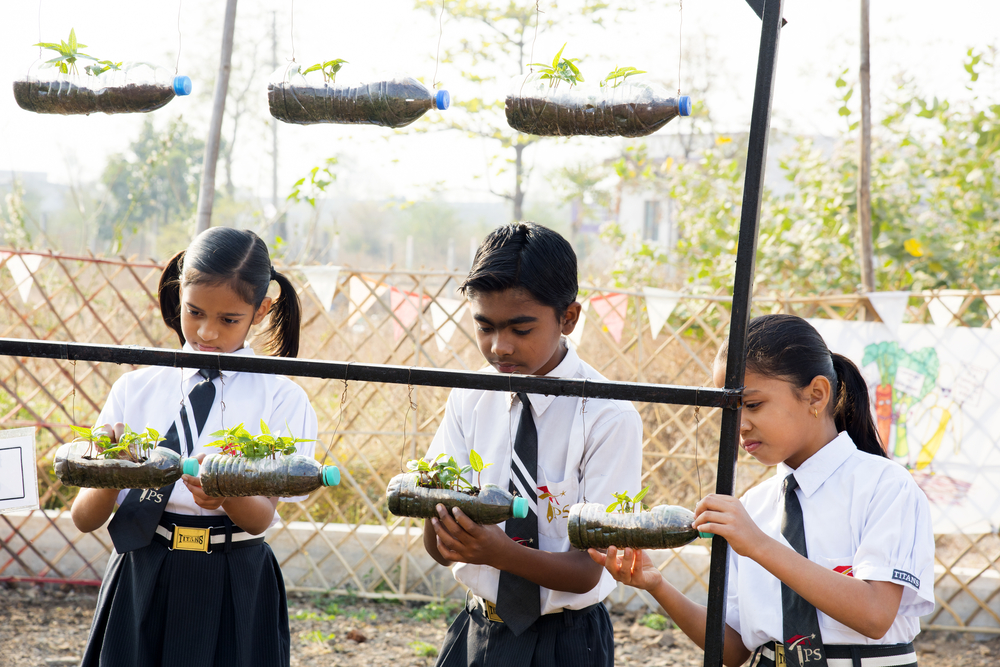Part of the Food Policy Snapshot Series
Policy name: School Nutrition (Kitchen) Gardens
Overview: The Ministry of Human Resource Development (MHRD) in India has issued guidelines to all schools in the country for setting up School Nutrition Gardens (also called Kitchen Gardens). These gardens will provide students with places to learn about growing and to grow their own food. The goal is to teach all students in India that growing is independence, and possible even in a crowded urban environment. The guidelines also suggest that students learn to appreciate all parts of a fruit and vegetable, and other ways to “think outside the box.”
Location: India
Population: 1.4 billion
Food policy category: Sustainable Agriculture; Diet and Nutrition; Food Insecurity
Program goal: To teach children the lifelong skill of growing their own food.
How it works: Krishi Vigyan Kendras in India are “farm science centers” where farmers and university scientists collaborate. These Centers partner with the Department of Agriculture/Horticulture, Food and Nutrition Boards, agriculture universities, and the Forest Department to supply students with seeds, saplings, manure, as well as training and technical assistance to create School Nutrition Gardens.
Schools in urban areas throughout India are encouraged to grow fruits and vegetables in pots on terraces or rooftops, or to grow plants that will climb walls and need a minimal amount of space. Students will be responsible for managing the gardens with their teachers’ help.
The Ministry of Human Resource Development (MHRD) guidelines suggest that every class should spend one or two hours per week in their school’s garden. Additionally, school eco clubs (which focus on improving environmental conditions) should be established to provide extra opportunities for students and their parents to become involved in planting and cultivating fruits and vegetables.
The food grown in school nutrition gardens can be incorporated into school meals. School cooks will be encouraged to engage in cooking competitions to create innovative and tasty dishes featuring items grown by the students.
Progress to date: In October of 2019 the MHRD sent guidelines for the program to all Chief and Education Secretaries in every state and union territory throughout India. Some states, such as Karnataka, already have successful school gardens in place, while others are still beginning to implement the program.
Why it is important: India has the largest undernourished population in the world: 194.4 million people, or 14.5 percent of the population. Gardening is a sustainable and inexpensive way for individuals to access healthy foods. Instituting kitchen gardens in every school in the country can teach children how to grow their own food. Furthermore, studies have shown that when children grow their own food they are more likely to eat it and bring healthy eating behaviors back to their families.
This program aims to:
- Address malnutrition & micronutrient deficiencies by improving the consumption of freshly grown vegetables
- Give children first-hand experience with nature and gardening.
- Increase knowledge among students about the nutritional aspects of vegetables and the harmful effects of junk food.
Program/Policy initiated: On October 15, 2019, all schools in India were provided with guidelines to implement school nutrition gardens.
Point of contact: N/A
Similar practices: Finland’s “Model Vihti” is another nationwide program that focuses on both gardening and farming in schools.
While national directives for school gardens are not prevalent throughout the world, gardening programs are becoming increasingly popular in schools all over the world. Several organizations in the United States, including Green Bronx Machine, Harlem Grown, Slow Food USA, Edible Schoolyard, Growing Minds, and Action for Healthy Kids support individual schools in their gardening efforts.
Evaluation: No evaluation measures are in place yet. Most schools are still planning and developing their gardens.
Learn more:
- 5 Benefits of School Gardens (Food and Agriculture Organization of the United Nations)
- Let it Grow (Harvard Graduate School of Education)
- School Gardening Increases Knowledge of Primary School Students on Edible Plants and Preference for Vegetables (Food Science and Nutrition)
- School Gardens: A Qualitative Study on Implementation Practices (International Journal of Environmental Research and Public Health)
References:
- A Plant To Plate Pilot: A Cold‐climate High School Garden Increased Vegetable Selection But Also Waste (Acta Paediatrica)
- All Schools Should Set Up Kitchen Gardens: Centre (Hindustan Times)
- Bio-intensive Gardening Makes School Fun in Karnataka (UNICEF India)
- Centre Asks All Schools to Set Up Kitchen Gardens (The Times of India)
- Kitchen Gardens in Schools can Improve Nutritional Levels (Hindustan Times)
- “Model Vihti” (OECD)
- The National School Garden Program (Slow Food USA)
- School Garden (Action for Healthy Kids)
- School Gardens (Growing Minds)
- School Nutrition (Kitchen) Gardens Guidelines (Ministry of Human Resource Development)
- Set Up Nutrition Kitchen Gardens: MHRD to Schools (New Delhi Television)
- The State of Food Security and Nutrition in the World, 2019 (Food and Agriculture Organization of the United Nations)


